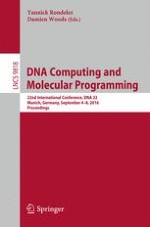2016 | OriginalPaper | Buchkapitel
On the Runtime of Universal Coating for Programmable Matter
verfasst von : Zahra Derakhshandeh, Robert Gmyr, Alexandra Porter, Andréa W. Richa, Christian Scheideler, Thim Strothmann
Erschienen in: DNA Computing and Molecular Programming
Aktivieren Sie unsere intelligente Suche, um passende Fachinhalte oder Patente zu finden.
Wählen Sie Textabschnitte aus um mit Künstlicher Intelligenz passenden Patente zu finden. powered by
Markieren Sie Textabschnitte, um KI-gestützt weitere passende Inhalte zu finden. powered by
